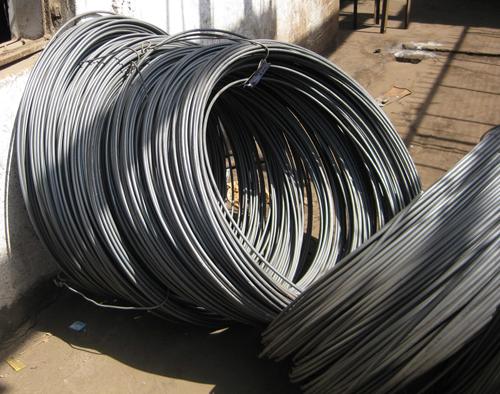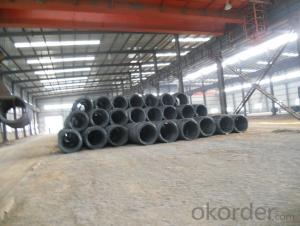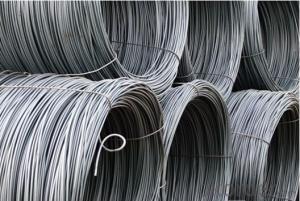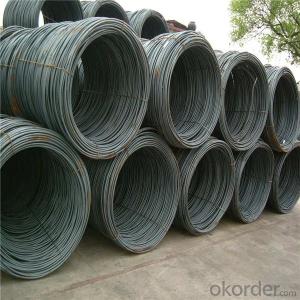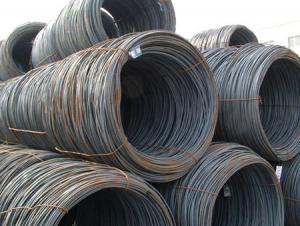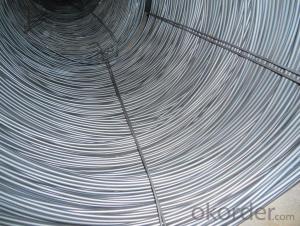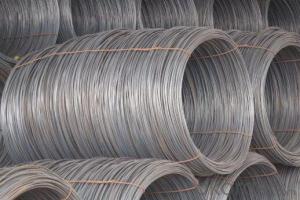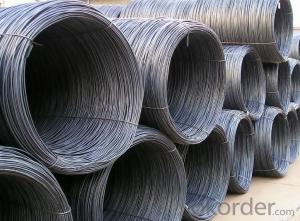Steel Wire Rod SAE1008 SAE1006 SAE1018
- Loading Port:
- China Main Port
- Payment Terms:
- TT or LC
- Min Order Qty:
- -
- Supply Capability:
- -
OKorder Service Pledge
OKorder Financial Service
You Might Also Like
Product Description:
OKorder is offering Steel Wire Rod SAE1008 SAE1006 SAE1018 at great prices with worldwide shipping. Our supplier is a world-class manufacturer of steel, with our products utilized the world over. OKorder annually supplies products to European, North American and Asian markets. We provide quotations within 24 hours of receiving an inquiry and guarantee competitive prices.
Product Applications:
Steel Wire Rod SAE1008 SAE1006 SAE1018 are ideal for structural applications and are widely used in the construction of buildings and bridges, and the manufacturing, petrochemical, and transportation industries.
Product Advantages:
OKorder's Steel Wire Rod SAE1008 SAE1006 SAE1018 are durable, strong, and resist corrosion.
Main Product Features:
· Premium quality
· Prompt delivery & seaworthy packing (30 days after receiving deposit)
· Corrosion resistance
· Can be recycled and reused
· Mill test certification
· Professional Service
· Competitive pricing
Product Specifications:
Steel Grade: Q195/235, SAE1006-1018B Standard: ASTM, GB
Diameter: 5.5mm, 6.5mm, 7mm,8mm,9mm,10mm,12mm,14mm
Diameter tolerance: ±0.3mm Type: in coil, coil weight around 2MT
Technique: Hot Rolled Place of Origin: China Mainland
Surface: round, no twisted, light and smooth Brand Name: HSKY
Chemical Composition: (Please kindly find our chemistry of our material based on Q195、Q235A and Q235B as below for your information)
Trademark | Rank | Chemical composition (quality score) % | |||||
C | Si | Mn | S | P | |||
| ≤ |
| ≤ | ≤ | |||
Q195 |
| 0.06-0.12 | 0.30 | 0.25 | 0.050 | 0.045 | |
Q235 | A | 0.14-0.22 | 0.30 | 0.30-0.65 | 0.050 | 0.045 | |
Q235 | B | 0.12-0.20 | 0.30 | 0.30-0.70 | 0.045 | 0.045 | |
Trademark | Rank | Pulling Test | |||||
Bend PointΔs/Mpa | Tensile Strength | Elongation Ratioδ5% | |||||
Thickness (Diameter) /MM | Thickness (Diameter) /MM | ||||||
≤16 | 16-40 | ≤16 | 16-40 | ||||
≥ | ≥ | ||||||
Q195 |
| 195 | 185 | 315-390 | 33 | 32 | |
Q235 | A | 235 | 225 | 375-500 | 26 | 25 | |
Q235 | B | 235 | 225 | 375-500 | 26 | 25 | |
Usage and Applications of Carbon Steel Wire Rod:
After hot-rolled the products shaped into coil and delivery as finished product, including round, square, rectangular, hexagonal and so on. Since most of the products are round, it is generally called wire rod. Carbon steel wire rod is widely used in construction and manufacturing. Carbon steel wire rod is mainly used for reinforcement of reinforced concrete and welded structure or reprocessed (roberts , nail, etc.) materials, especially used to produce wire drawing, welding electrode, nails, spring, electronic, precise machinery parts and so on.
Packaging & Delivery of Carbon Steel Wire Rod:
Packaging Detail: products are packed in coil, each coil weight around 2 MT, and then shipped by container or bulk vessel
Delivery Detail: within 45 days after received deposit or LC.
Label: to be specified by customer, generally, each bundle has 1-2 labels
Trade terms: FOB, CFR, CIF
FAQ:
Q1: Why buy Materials & Equipment from OKorder.com?
A1: All products offered byOKorder.com are carefully selected from China's most reliable manufacturing enterprises. Through its ISO certifications, OKorder.com adheres to the highest standards and a commitment to supply chain safety and customer satisfaction.
Q2: How do we guarantee the quality of our products?
A2: We have established an advanced quality management system which conducts strict quality tests at every step, from raw materials to the final product. At the same time, we provide extensive follow-up service assurances as required.
Q3: How soon can we receive the product after purchase?
A3: Within three days of placing an order, we will begin production. The specific shipping date is dependent upon international and government factors, but is typically 7 to 10 workdays.
Images:
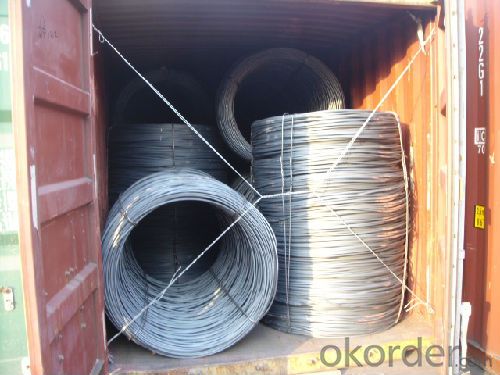


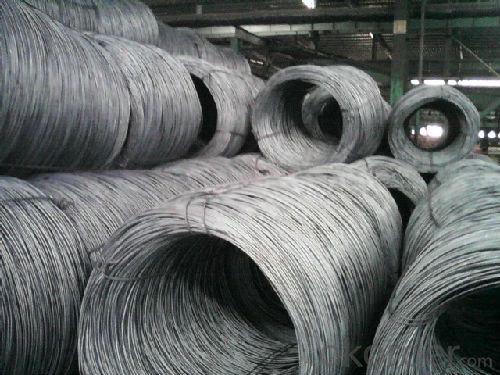
- Q: What are the advantages of using steel wire rod in architectural applications?
- There are several advantages of using steel wire rod in architectural applications. Firstly, steel wire rod offers exceptional strength and durability, making it suitable for various structural elements such as beams, columns, and reinforcements. Its high tensile strength allows for the creation of lightweight and slender designs without compromising on strength. Additionally, steel wire rod is highly versatile and can be easily shaped, bent, and molded to meet specific architectural requirements. This flexibility allows for intricate and complex designs to be realized, enhancing the aesthetic appeal of architectural structures. Furthermore, steel wire rod has excellent corrosion resistance properties, ensuring longevity and minimizing maintenance costs. It can withstand harsh environmental conditions, making it suitable for both indoor and outdoor architectural applications. Lastly, steel wire rod is a sustainable choice as it is 100% recyclable. Its recyclability reduces the environmental impact and promotes a circular economy. Overall, the advantages of using steel wire rod in architectural applications include strength, versatility, durability, corrosion resistance, and sustainability.
- Q: What are the trade regulations for steel wire rod?
- Trade regulations for steel wire rod vary depending on the country or region. However, some common regulations may include quality standards, labeling requirements, and tariffs or quotas imposed to protect domestic steel industries. It is important to consult the specific regulations set by the importing and exporting countries to ensure compliance and smooth trade operations.
- Q: What are the common industry skills for steel wire rod suppliers?
- Some common industry skills for steel wire rod suppliers include knowledge of steel production processes, understanding of steel grades and specifications, expertise in quality control and inspection procedures, proficiency in inventory management, strong communication and negotiation skills, and the ability to build and maintain relationships with customers.
- Q: What are the different types of steel wire rod surface cleaning processes?
- There are several different types of steel wire rod surface cleaning processes, including mechanical cleaning methods such as shot blasting and wire brushing, chemical cleaning methods like pickling and phosphating, and thermal cleaning methods such as flame or plasma cleaning. Each process has its own advantages and is used based on the specific requirements and desired outcome for the steel wire rod surface.
- Q: How is steel wire rod used in the manufacturing of wire racks?
- Steel wire rod is a crucial component in the manufacturing of wire racks as it serves as the primary material used to create the framework and structure of the rack. The wire rod is initially processed through a series of steps such as heating, rolling, and drawing to transform it into a thin, long, and continuous wire. This wire is then bent, shaped, and welded to form the different parts of the wire rack, including the sides, shelves, and supports. The high tensile strength and durability of steel wire rod make it an ideal choice for wire racks as it can bear heavy loads and withstand constant use without bending or breaking. Additionally, the steel wire rod's corrosion resistance properties ensure that the wire racks remain sturdy and long-lasting, even in environments with high humidity or exposure to moisture. The versatility of steel wire rod allows manufacturers to create wire racks in various sizes and designs to cater to different storage needs. The wire rod can be easily manipulated to form different shapes, allowing for the creation of wire racks with adjustable shelves or collapsible features. This flexibility in design makes wire racks highly customizable and adaptable for use in various settings, such as homes, offices, warehouses, or retail stores. Furthermore, the use of steel wire rod in wire rack manufacturing enables efficient production processes. The wire rod can be easily cut, shaped, and welded using automated machinery, reducing production time and costs. This ease of manufacturing also allows for mass production of wire racks, ensuring a steady supply to meet market demands. In conclusion, steel wire rod plays a vital role in the manufacturing of wire racks by providing the necessary strength, durability, and versatility required for these storage solutions. Its ability to be easily shaped, resistance to corrosion, and cost-effectiveness make it an ideal material for creating wire racks of various sizes and designs.
- Q: How does the thermal conductivity of steel wire rod vary with different heat treatment processes?
- The thermal conductivity of steel wire rod can vary with different heat treatment processes. Heat treatment processes such as annealing or quenching can affect the microstructure of the steel, leading to changes in its thermal conductivity. Annealing, for example, can result in a more uniform and refined grain structure, increasing the thermal conductivity of the steel wire rod. On the other hand, quenching, which involves rapid cooling, can lead to a harder and more brittle microstructure, potentially decreasing the thermal conductivity. Therefore, the specific heat treatment process employed can have a significant impact on the thermal conductivity of steel wire rod.
- Q: What are the common industry research initiatives for steel wire rod?
- Common industry research initiatives for steel wire rod include improving production processes to enhance efficiency and reduce costs, developing new alloys and compositions to enhance the mechanical properties of the wire rod, exploring innovative techniques for surface treatment and coating to improve corrosion resistance, investigating the impact of different processing parameters on the wire rod's microstructure and mechanical properties, and studying the use of recycled materials in wire rod production to promote sustainability and environmental responsibility.
- Q: How is the cleanliness of steel wire rod assessed?
- The cleanliness of steel wire rod is assessed through various methods and techniques to ensure high-quality standards. One common method used is visual inspection, where trained personnel thoroughly scan the surface of the wire rod for any visible defects such as scale, cracks, pits, or other surface irregularities that could affect its cleanliness. Another technique is magnetic particle testing, which involves placing the wire rod in a magnetic field and applying magnetic particles to the surface. Any discontinuities or defects in the material will cause the particles to be attracted and accumulate, making them visible under proper lighting conditions. Ultrasonic testing is also employed to assess the cleanliness of steel wire rod. This non-destructive testing method uses high-frequency sound waves to detect internal defects such as inclusions, voids, or other imperfections that are not visually apparent. Ultrasonic waves are transmitted through the wire rod, and any reflections or changes in the waves' pattern can indicate the presence of defects. Chemical analysis is another crucial aspect of assessing cleanliness. Samples of the wire rod are taken and subjected to chemical tests to determine the composition and impurity levels. This analysis can identify contaminants such as sulfur, phosphorus, or other elements that may affect the cleanliness of the steel. Overall, a combination of visual inspection, magnetic particle testing, ultrasonic testing, and chemical analysis is typically used to assess the cleanliness of steel wire rod. By implementing these methods, manufacturers can ensure that the wire rod meets the required cleanliness standards, guaranteeing its suitability for various applications.
- Q: What are the main factors influencing the choice of steel wire rod warranty?
- The main factors influencing the choice of steel wire rod warranty are the quality of the steel wire rod, the reputation of the manufacturer, and the terms and conditions of the warranty itself. Firstly, the quality of the steel wire rod plays a significant role in the choice of warranty. Buyers would prefer a higher quality product that is less likely to have defects or issues, thus reducing the need for warranty claims. The overall strength, durability, and performance of the steel wire rod are crucial factors in determining the level of confidence in the product and, subsequently, the warranty. Secondly, the reputation of the manufacturer also influences the choice of warranty. A manufacturer with a proven track record of producing high-quality steel wire rods and providing reliable warranties is more likely to instill trust in the buyer. Positive reviews, testimonials, and references from other customers can contribute to the decision-making process, as they provide insights into the manufacturer's commitment to customer satisfaction and after-sales service. Lastly, the terms and conditions of the warranty itself are an essential factor. Buyers consider factors such as the duration of the warranty, the coverage it provides, and any limitations or exclusions mentioned in the warranty documentation. A longer warranty period and comprehensive coverage, including protection against manufacturing defects or premature failure, are often preferred. Additionally, factors like the process for filing warranty claims, the responsiveness of the manufacturer's customer service, and the ease of warranty fulfillment are also taken into account. In summary, the main factors influencing the choice of steel wire rod warranty include the quality of the product, the reputation of the manufacturer, and the terms and conditions of the warranty. Buyers prioritize a high-quality product, a reputable manufacturer, and a warranty with favorable terms and comprehensive coverage.
- Q: How are steel wire rods used in the manufacturing of springs?
- Steel wire rods are used in the manufacturing of springs by being shaped and coiled to create the desired spring shape and characteristics. The wire rods are typically formed into coils or helical shapes, which are then heat-treated and tempered to enhance their strength and flexibility. The resulting springs can be used in various applications, such as automotive suspensions, mechanical devices, and household appliances.
Send your message to us
Steel Wire Rod SAE1008 SAE1006 SAE1018
- Loading Port:
- China Main Port
- Payment Terms:
- TT or LC
- Min Order Qty:
- -
- Supply Capability:
- -
OKorder Service Pledge
OKorder Financial Service
Similar products
Hot products
Hot Searches
Related keywords

